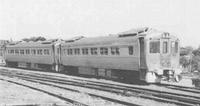


Chapter 7
I The First 100 Years 1788-1888
II Railways
i Location of the Railway
ii Track
iii Bridging and Tunnelling
iv Dams for Engine Water
v Locomotives and Rolling Stock
vi Signalling and Telecommunications
vii 1900/1988-The New Century
viii The Garratt Locomotive
ix Steam Locomotive Practice
x Motor Railcars
xi Signalling
xii Electric Tramways
xiii Electric Railways - Direct Current
xiv Electric Railways - 25 kV ac
xv Diesel Traction
xvi Alignment and Track
xvii Operations
III Motorised Vehicles
IV Aviation
V Modern Shipping
VI Innovative Small Craft
VII Conclusion
VIII Acknowledgements
IX Contributors
References
Index
Search
Help
Contact us

Motor Railcars
The challenge of the automotive era was met by stoic indifference on the part of the Australian railways. True, competition from the trams (another and usually a local Government Department) helped to stimulate suburban electrification, but the real incentive was to reduce the costs, filth and unimpressive commercial speeds of an intensive steam suburban service. The condition of roads and State Government regulation of bus competition kept the main-line steam trains comfortably filled until the general ownership of private motor cars after the First World War. The country branch and feeder services were to be the first Australian railway applications of automotive era technology.We can note, briefly, the use of adapted chassis of petrol engine motor cars (Queensland 1906) trucks (N.S.W. 1910) and buses (Queensland and Victoria, post the First World War with a crude railway bogie under the engine, a railway axle at the back, and a form of shelter for the patrons. W.A.'s first railcar was a custom built 2-axle railway vehicle rather like a motorised box wagon. All served the branches efficiently for up to 40 years, cut the costs of a steam train, and provided a faster service than the mixed train with its tiresome en route shuntings to detach and pick up wagons.

Where the converted chassis approach was inadequate, a motorised bogie coach was applied, usually custom built and of imported design. Queensland and Victoria used the petrol-mechanical McKeen Car (U.S.A. 1911); Victoria the Electromotive petrol-electric car (U.S.A. & Newport Shops 1928 and still running with diesel engines in 1986) and S.A. (later Victoria) the Brill petrol mechanical car. All these had steel bodies, as did contemporary (from mid-1920s) Sentinel-Cammell steam railcars imported from the U.K. by Tasmania.
The first, and by far the most innovative and truly Australian railcar technology was the 42 ft Rail Motor Car introduced in N.S.W. for the Christmas traffic in 1923. With minor modifications including re-engining with diesel hydraulic power units and fitting of multiple unit control for operation in a train, it was used in squadron service for 62 years. This is believed to be a world record and attests to the very advanced concepts used. The design incorporated the N.S.W. Railways' experience with a successful conversion of truck chassis, and a moderately successful attempt to motorise a coach with a Leyland petrol engine whose rotation was made reversible to reverse the direction of motion.[8]
The 1923 car for which credit is due to R. A. Holloway, introduced a number of features that were revolutionary for the time, all of them directed at achieving lightness while preserving traditional railway durability. The underframe was a lightweight, all welded, triangular section truss with welded headstocks. It weighed 2.1 ton. The bogies were an inside bearing all welded type with dished wheel webs, welded to rims and hubs (later replaced by slightly heavier conventional bogies and spoked wheels) and the body was built of timber, carefully designed as to lightness, but of high durability.
Organisations in Australian Science at Work - COMENG; N.S.W. Railways; Queensland Railways
People in Bright Sparcs - Holloway, R. A.; Macfarlane, Ian B.; Smith, A. E.
 |
Australian Academy of Technological Sciences and Engineering |  |
© 1988 Print Edition pages 468 - 469, Online Edition 2000
Published by Australian Science and Technology Heritage Centre, using the Web Academic Resource Publisher
http://www.austehc.unimelb.edu.au/tia/462.html